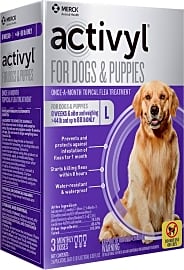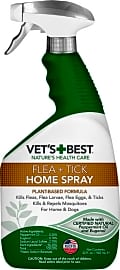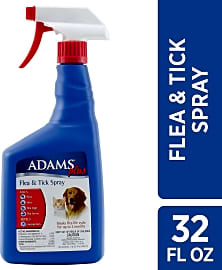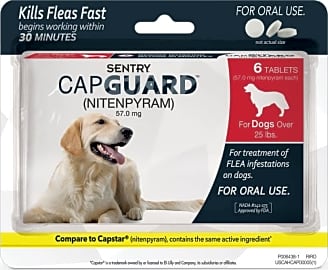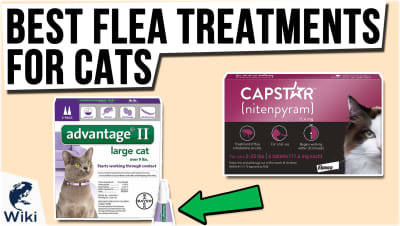The 10 Best Dog Flea Treatments

This wiki has been updated 39 times since it was first published in December of 2015. When it comes to the comfort, health, and safety of your furry friends, protecting them from blood-sucking pests is just as important as giving them proper nutrition and veterinary care. These flea treatments offer a variety of application methods ranging from topical formulas to pills and sprays, some of which can even get rid of ticks and mosquitoes. But always keep them out of a child's reach. When users buy our independently chosen editorial choices, we may earn commissions to help fund the Wiki.
Editor's Notes
April 23, 2020:
There are few insects I hate as much as fleas and mosquitoes! I'm not afraid to admit that. In my area, flea season intensifies in July and usually lasts through September and even into October when the heat of early fall persists. Fleas can be particularly problematic during years when we don't have a lot of rain (a common occurrence in places like California). All I have to see is one of those little suckers landing on my dog's head and my heart sinks. I just want to grab the parasite and drown it in soapy water, sparing my furbabies any discomfort. Thankfully, we have the convenience of various topical and oral flea treatments to get us through the tough summer months when vermin like that are highly active. Once treated, we usually don't see too many for the summer until we get to the end of the formula's potency, typically 28-30 days after applying it. While certain flea medicines can be used in conjunction with a flea collar, we find the topicals most helpful for our needs. Furthermore, you don't have to pay an arm and a leg for a 3-6 month supply. I will say that geographic location matters. Flea problems can potentially be worse in a place like Miami, Florida (due to the year-round warmth and humidity) than they might be in places like Los Angeles or San Francisco, California.
We've added a mix of topical treatments, sprays, and oral medications designed to eliminate these pests, break their life cycle, and prevent re-infestations so you can get back to enjoying life with your pets. A common theme among many of our topical choices is their use of neurotoxins to paralyze the insect from the inside out, rendering it unable to feed and resulting in its death without harming your dog. Bayer K9 Advantix II not only kills fleas, but it's also effective against ticks, biting flies, mosquitoes, and chewing lice. In most cases, just brief exposure of a flea's exoskeleton to the product is enough to give it a death sentence, meaning the pest doesn't have to bite your dog first in order for it to die. Frontline Plus has a relatively well-known reputation and works in a similar fashion. It also comes as a six-month supply.
We've also added Activyl Topical. I've personally used this product several times on my dogs and find that it works quite well, at least in California. For the most part, my pets are indoor animals, but our backyard gets fleas from time to time, so this definitely helps keep them under control during the warm, humid months. Its bioactivation technology further sets it apart from some of the other items on the list.
Elanco Capstar is a good alternative to dropping pesticides into a pup's coat, but it will have to be administered often, depending on where you live.
Also included are Vet's Best Home Spray and Adams Plus, the former of which uses natural essential oils and ingredients to keep fleas at bay, while the latter leverages an insect growth hormone to break the life cycle. We've continued the spray theme with the addition of Wondercide Natural. Although it's on the pricey side, it's available in several scents and remains gentle on a pup's skin. It can also be applied to your rugs and furniture.
None of these products should be left within a child's reach. Additionally, many are unsafe for use on felines (unless otherwise stated). However, we have a list of products specially formulated for cats. Since many of these treatments are pesticides, you should also use a good pair of disposable latex gloves when applying them to your pet's coat.
Special Honors
Trifexis Containing the two active ingredients spinosad and milbemycin oxime, Trifexis is a monthly-administered, beef-flavored oral tablet designed to kill fleas, prevent re-infestations, and treat and control adult hookworm, roundworm and whipworm infections from inside a dog's body. Available in five dosage strengths (according to a canine's weight), Trifexis is safe for both dogs and puppies as young as eight weeks weighing five pounds and up. Trifexis normally requires a prescription from a professional veterinarian. trifexis.com
NexGard NexGard is a prescription-based, orally-administered soft chew using the active ingredient afoxolaner to protect a pup against fleas before the vermin can lay their eggs. NexGard is also effective at killing several species of dog tick, including the Lone Star, Black-legged, American, and Brown varieties before they can spread Lyme disease. NexGard is available in several dosage strengths that support a weight range between four and 121 pounds. nexgardfordogs.com
Terminix If you're afraid that your pest problem is getting out of control, Terminix is a worthy consideration in conjunction with spot-on and/or oral treatments. With more than 90 years in business, Terminix provides professional and proactive pest control solutions that prevent harmful infestations by a variety of parasites and creepy critters, including ants, cockroaches, fleas, mosquitoes, rodents, spiders, termites, and ticks. Some degree of preparation for appointments is required to ensure the treatment is effective. This can involve removing clothes, food, and toys from floors, thoroughly vacuuming carpets and rugs (including under the furniture), and planning to be out of the house for a few hours while the treatment dries. The company can also provide free inspections and quotes. Terminix also offers dedicated services for insulating crawl spaces and attics. terminix.com
Why Do Dogs Get Fleas?
Unless the dog is washed using only medicinal shampoos and flea-repellent conditioners, the average adult flea pays little attention to the personal hygiene of their host.
The small, brown insects found on the skin of many canines in warmer months are only one species of the Siphonaptera order of insects. Fleas are preferential creatures; so much so that different species feed off of different animals. For instance, Ctenocephalides felis is the flea most attracted to both domestic and wild felines, whereas the Pulex irritans species prefer to feed off of humans. The canine flea is properly known as Ctenocephalides canis. In all, there are over two thousand known species of flea.
While all fleas have their preferred host; they will happily jump from one species to another. It is just as common for a canine flea to bite a human or a feline. The anatomy of the common canine flea is such that the legs are nearly as long as the body; which is relatively flat and aerodynamic. Fleas propel themselves from host to host using these long legs; constantly seeking their perfect habitat.
Fleas prefer temperatures of 65-85 degrees Fahrenheit and humidity levels of close to 80 percent. For the Ctenocephalides canis species; the perfect habitat is the warm, humid area on a dog's skin and fur. Canine fleas are most likely to congregate in the dog's armpits, under their ears, and just above their tail.
Infestations are not solely due to poor canine hygiene, as is commonly thought. Unless the dog is washed using only medicinal shampoos and flea-repellent conditioners, the average adult flea pays little attention to the personal hygiene of their host. As one of many common canine ectoparasites, they only survive by feeding on the blood of their hosts. Because of this, the only consideration in a flea's mind is where the next meal comes from. Flea infestations simply occur through contact with other animals or contact with fleas in the animal's environment.
Do Fleas Pose A Real Threat?
When pruritus first appears in dogs, it may be difficult to ascertain a definite cause. Dietary factors should be considered, as well as the possibility of allergic skin disorders which have little to do with ectoparasites. When the symptoms do appear, there are very typical signs to look out for. One benefit of pruritis caused by Ctenocephalides canis is that the fleas themselves may be observed on the dogs skin. Another definite sign of a flea infestation is known as flea dirt; the fecal matter of fleas which resembles black pepper granules scattered across the epidermis of the animal.
The easiest way to ameliorate symptoms of a flea infestation is through the use of various dog flea treatment options.
Aside from simply annoying their domestic hosts, fleas may actually pose a threat to the well-being of the animals they bite. The flea’s bite is most commonly associated with the pruritis experienced by both humans and animals; severe itching of the skin disproportionate to the size of the small wound. For sensitive dogs, the experience can be quite severe.
Some domestic pets are hypersensitive to the flea's saliva. The condition is known as flea allergy dermatitis; and causes canines to itch over a broad area of the body due to one single flea bite. Over time, this can lead to hair-loss, inflammation and even secondary skin infections. Fleas may also transmit tapeworms and diseases to their canine hosts.
The easiest way to ameliorate symptoms of a flea infestation is through the use of various dog flea treatment options. As science has explored novel treatment methods and identified ways of targeting multiple species of fleas; dog flea treatment options provide safe and effective ways to reduce flea populations both on the animal and in their surrounding environments.
Why Are Regular Dog Flea Treatments Necessary?
In large part, dog flea treatments only work for a predetermined amount of time; and this has much to do with the strength and safety of medications and the life cycle of the fleas themselves. The life cycle of a flea varies by species; and plays an integral role in treatment methods.
The process begins just two days after inhabiting the host.
There are four developmental stages in a flea's life cycle. An adult flea lives its life entirely on a host; feeding off of the host's blood and laying eggs on its skin. These eggs, up to 2000 of them, may start out on the host, but they readily fall about the environment as the host moves around. The process begins just two days after inhabiting the host. An egg can take up to ten days to hatch, giving plenty of time for many effective dog flea treatment medications to lose potency and need reapplication.
The hatched larvae are the only free living versions of fleas; as they feed off of organic material and flea dirt found in their environment. At the end of the larval stage, a flea will wrap itself in a cocoon for its pupal stage; lasting for a month on average. When it emerges it is an adult flea, ready to look for a host to live out the rest of its days upon. However if left undisturbed, flea pupae can survive for five or six months before emerging as an adult. For this reason alone, reapplication of dog flea treatments is necessary to avoid re-infestation.



